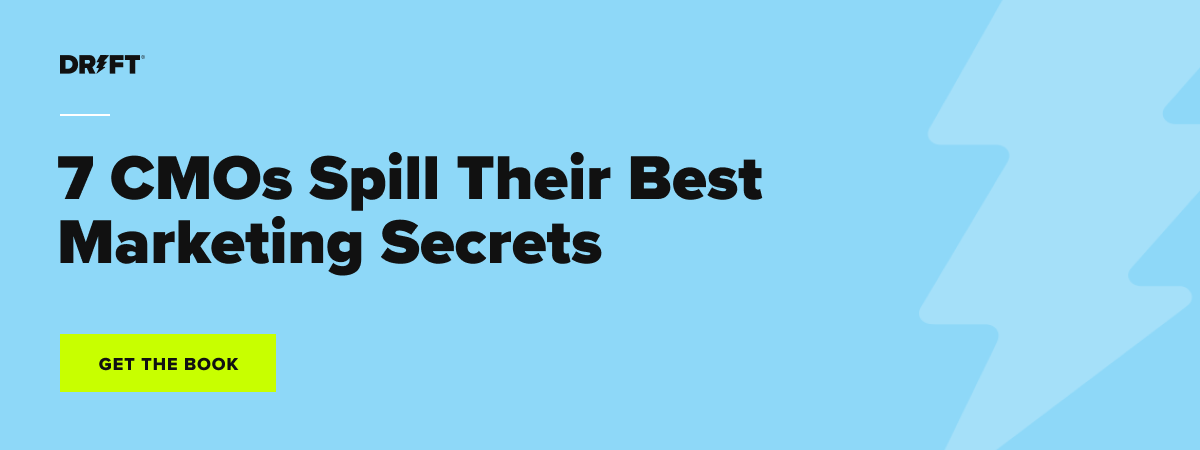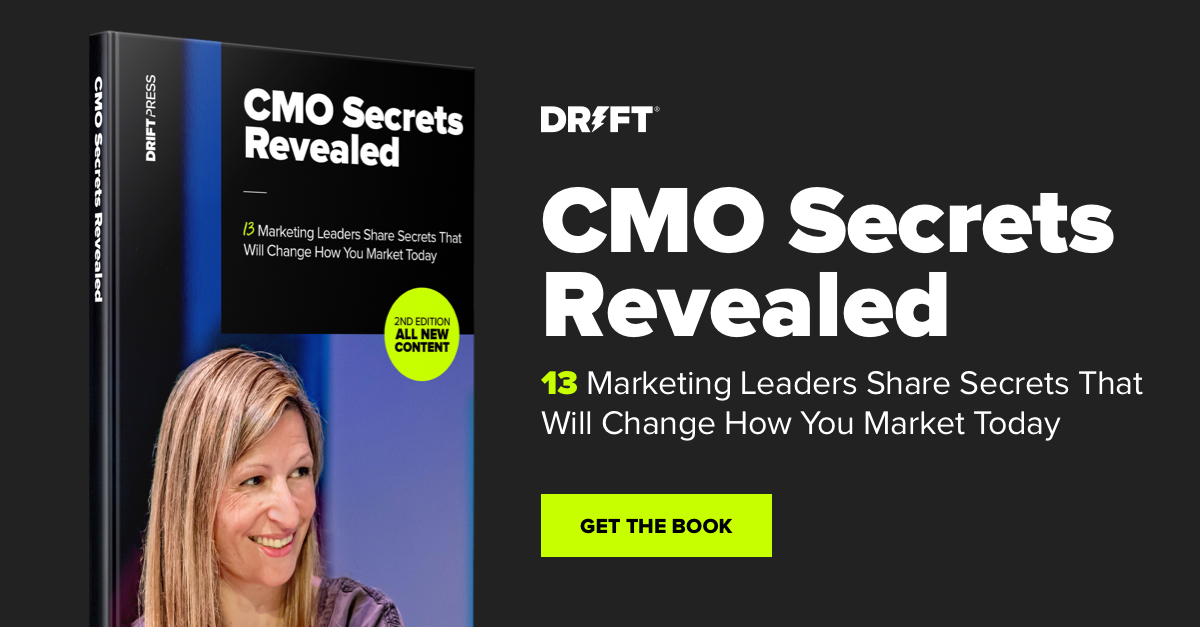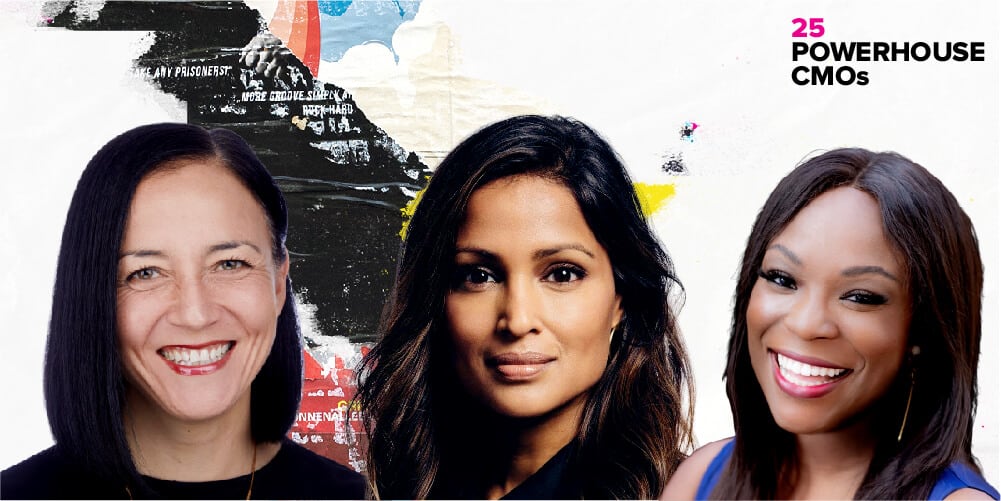When you hear the word “people-pleaser,” it probably doesn’t conjure the most…favorable image.
Is that actually fair, though?
As Drift’s podcast producer, I have the awesome job of finding great guests, strategizing episode content, and pulling insights from the conversations that follow.
And it turns out there’s a lot you can learn. In fact, we’ve taken over a dozen episodes and condensed them into our newest iteration of the CMO Secrets Revealed book.
But as I was scouring through recent episodes, I noticed an interesting trend. More and more CMOs are talking about catering to customers (not just sending out a survey and calling it done).
When you look at it in this context, people-pleasing is a GOOD thing.
So if your fear of people-pleasing is stopping you from going all out for your customers, I’m here to tell you that it’s okay to bend over backwards — for the right audience.
Don’t just take that from me. Here’s what four CMOs from top B2B brands have to say about people-pleasing.
Janine Pelosi: “People Have to Like You”
When the pandemic hit and everyone had to transition to a remote lifestyle, Zoom quickly became a household name.
Even the CMO of Zoom, Janine Pelosi, was surprised. In June of 2020, she told CNBC that she didn’t know the exact secret behind Zoom’s meteoric rise at the height of the global lockdowns.
But what she does know is that the Zoom team is dedicated to building authentic relationships with their customers. And that means creating an app that is secure and easy to use, whether that’s for family gatherings or remote work.
“We’re a little bit more old school,” Janine told us. “We want to bring our customers to the forefront.”
It doesn’t get said a lot, but being liked matters big time for marketers. Here’s what Janine told us about how Zoom crafts messages that people will like:
“When I came [to Zoom], I kept hearing, “Zoom, it just doesn’t suck.” So we ended up putting “Video conferencing that doesn’t suck” on a bunch of billboards all over Silicon Valley, right? Up and down the 101, you’re going to hear it on the radio, the sides of buses, you name it. And it really resonated with people.
Now, fast forward a couple of years, we kind of have the opposite. We have “Meet happy,” which people just love, and that kind of came out of a very interesting political climate. There are just lots of hard things going on in the world, and we wanted a happy message. Bringing in a great, happy message at the end of the day, really resonated with folks.”
When your message appeals to a lot of people, it helps spread the word about your product and makes you stand out against your competitors. And keeping that message relevant shows that you’re just as real as the people you’re selling to.
Listen to the full episode here 🎧
Leela Srinivasan: “Feedback Is the Secret Sauce”
Collecting feedback from your customers is the norm.
What varies is how you actually use it.
Leela Srinivasan, CMO of Checkout.com, told us in an episode of Marketing Swipe File that customer feedback should have a hand in everything you do.
And that’s not just for small details in your messaging and copy. Leela says that feedback should be part of every big decision that marketers make.
“I’ve used customer feedback as an important input into how we’re thinking about packaging and pricing. This includes designing packages from scratch, based on an individual’s willingness to pay for certain features, to running qualitative research with decision-makers. And having them react in real time to different price points, using Van Westendorp and all these other conventions to make sure we have as much input as possible in that final price. You can really shoot yourself in the foot if you go-to-market with something that doesn’t have the features people will pay for, or that it is priced incorrectly.”
As Leela points out, you don’t need to do a bunch of guesswork to figure out what your customers want. By actively seeking out feedback, you ensure that you’re addressing the issues that your customers are facing and implementing new features that they’ll find valuable.
Listen to the full episode here 🎧
Katharine Mobley: “Listen First, Strategize Second”
Sometimes, the people you need to please are the ones you work with every day.
Too often, marketers strategize and then chat with fellow workers to gain insights that will fit into their preexisting strategy. It becomes less about designing a better strategy and more about brainstorming webinar ideas or crafting snappy phrases for your landing page.
But Katharine Mobley, CMO of Real, knows that listening should always come first, especially when you’re preparing to shift visions or strategies. As she explained in this CMO Conversations episode, listening is also a smart move when first joining a new company.
“I tell everybody when I get there, ‘I’m going to be quiet. It’s going to make you a little unnerved for a while. Because I’m here to listen so that I can build a plan and implement it.’ So for six weeks I just listen to everybody — from all the key stakeholders in leadership to customer success and sales. I want to learn about all the different challenges that we’ve had, and dig into all the data. Sitting and listening to people lets me build a better marketing plan more quickly.”
If you show that you’re willing to listen, you’ll be able to build trust with the people around you. This will be crucial for when you want to start making big changes at your company.
For Katharine, listening is what enables you to make smart choices about your strategy. After all, you can only make meaningful changes by addressing the problems that your stakeholders are facing — and there’s no better way to do that than by hearing it straight from the people involved.
Listen to the full episode here 🎧
Mike Troiano: “Use Storytelling to Empower Sales”
How do you get a customer hooked with your sales pitch?
Mike Troiano, a.k.a the godfather of brand, has a simple answer: tell them a good story.
Mike is a serial entrepreneur, former CMO, and current venture capitalist at G20 Ventures. In this episode of Seeking Wisdom, Mike told us that the most important thing marketing can do is enhance sales productivity.
Good marketers are always tuned in to their customers’ responses. That feedback enables them to craft compelling stories that acknowledge the prospect’s pains and then provide a desirable solution. Sales can use these stories as a roadmap so that their conversations will be more empathetic and responsive to the prospect’s needs.
“We’re big fans of Simon Sinek. And his idea of “start with why” has always been fundamental to the way I approach marketing and communication. With a salesperson, you have to give them the tools to understand the challenges their customers are dealing with. Then, give them a set of discovery questions that enable them to surface those challenges. [You have to] help them to walk the customer through the negative consequences of those technical challenges, and paint the positive business outcomes that would come from a better way. Once you’ve done that, then you can start to define: What are the technical requirements required to realize that rosy picture?”
In Mike’s view, storytelling in sales is all about understanding the issues that your customers are facing and laying out a solution that addresses those concerns. What matters most of all is how your customers feel about what you’re selling.
Listen to the full episode here 🎧
Final Thought
Experienced CMOs have a lot of advice to give.
But the best ones will tell you that listening is one of the most important skills you can have. Once you get past the stigma of “people-pleasing,” you can build stronger connections with your customers and coworkers.
With a strong foundation in listening, you have a better shot at creating marketing campaigns that resonate with the people around you.










